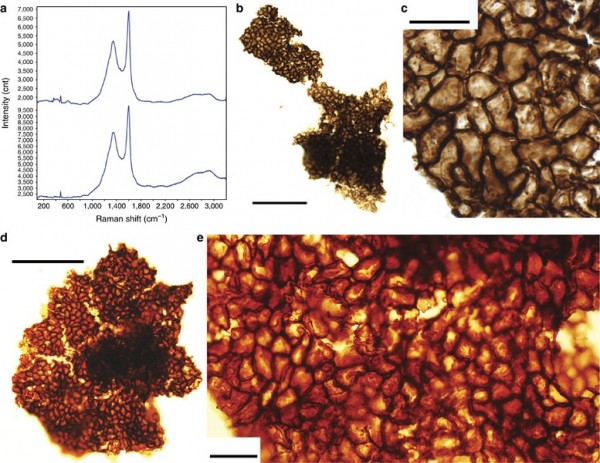World's First Complex Organisms Appeared 1 Billion Years Earlier Than Previously Thought
| Ana Verayo | | May 18, 2016 07:46 AM EDT |
(Photo : Nature Communications) Organic fragments showing cellular structure and Raman microspectroscopy.
Fossilized seaweed like organisms discovered on rocks in China are apparently considered to be the earliest form of living organisms on the planet, making them also the oldest ones, at 1.56 billion years old, that are composed of multiple cells similar to our own.
These newly discovered organisms are considered by scientists to thrive during a time in Earth's early stages, that is described to be the "boring billion" years of the evolutionary history of life on the planet.
Like Us on Facebook
Researchers describe the fossils to measure at 30 centimeters long and almost eight centimeters across, that were uncovered in the northern regions of China. These cellular structures reveal some distinct features that suggest that they are eukaryotes, that also include a nucleus similar to human cells.
According to co-author of the study, Maoyan Zhu from the Nanjing Institute of Geology and Palaeontology, these are considered to be the earliest known specimens of multicellular life that have not yet existed until 600 million years ago, specifically during the Cambrian Explosion where a rapid emergence of complex life first appeared on Earth.
This "boring billion" years is also known as Mesoproterozoic, where Zhu says that people will be able to rethink about the emergence of microscopic organisms during this time.
These 167 fossilized specimens possess different shapes and sizes but they all have one distinct feature which is a unique leaf shape, that are tapered along its edges where others are found to be round shaped or even shaped like a tongue.
According to co-author of the study, paleontologist Andrew Knoll of Harvard University, these larger multicellular eukaryotic organisms appeared right after the emergence of the very fist eukaryotic cells on Earth. Knoll says that eukaryotic cells, which are cells that have a membrane barrier and nucleus like our own, were known to first appear on the planet some time between 1.8 to 1.6 billion years ago.
The remarkable thing about this discovery is that it suggests how single celled organisms rapidly evolved by organizing themselves into multicellular forms and even more so, the unique fossilized shape of the specimens holds clues to the first evidence of photosynthesis.
He adds that modern organisms that possess the same shape today such as leaves and seaweed, suggest that this shape is photosynthetic, linking that eukaryotes adapted the process of photosynthesis, rather quickly during that time.
This new study is published in the journal, Nature Communications.
Tagsevolution of life on Earth, eukaryotes, multicellular organisms, complex organisms, Microbiology, first complex organisms on earth
©2015 Chinatopix All rights reserved. Do not reproduce without permission
EDITOR'S PICKS
-

Did the Trump administration just announce plans for a trade war with ‘hostile’ China and Russia?
-

US Senate passes Taiwan travel bill slammed by China
-

As Yan Sihong’s family grieves, here are other Chinese students who went missing abroad. Some have never been found
-

Beijing blasts Western critics who ‘smear China’ with the term sharp power
-

China Envoy Seeks to Defuse Tensions With U.S. as a Trade War Brews
-

Singapore's Deputy PM Provides Bitcoin Vote of Confidence Amid China's Blanket Bans
-

China warns investors over risks in overseas virtual currency trading
-

Chinese government most trustworthy: survey
-

Kashima Antlers On Course For Back-To-Back Titles
MOST POPULAR
LATEST NEWS
Zhou Yongkang: China's Former Security Chief Sentenced to Life in Prison

China's former Chief of the Ministry of Public Security, Zhou Yongkang, has been given a life sentence after he was found guilty of abusing his office, bribery and deliberately ... Full Article
TRENDING STORY

China Pork Prices Expected to Stabilize As The Supplies Recover

Elephone P9000 Smartphone is now on Sale on Amazon India

There's a Big Chance Cliffhangers Won't Still Be Resolved When Grey's Anatomy Season 13 Returns

Supreme Court Ruled on Samsung vs Apple Dispute for Patent Infringement

Microsoft Surface Pro 5 Rumors and Release Date: What is the Latest?










